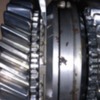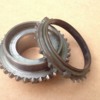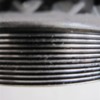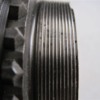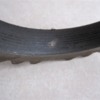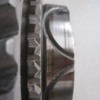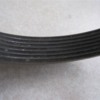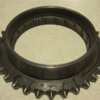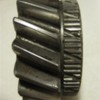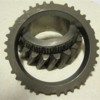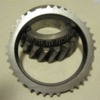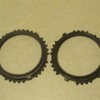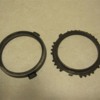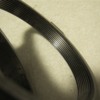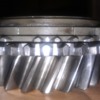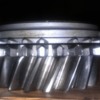Sorry to interject here but I think this thread needs more cowbell?
It doesn't matter to the synchro what that measurement is. 20 thousands is actually the correct answer to what it should be.
Everyone is misunderstanding what it does and how it works.
I agree with Butfoy. The cone on the gear is rarely worn beyond use. In fact, you won't even be able to tell the difference between a used one and a new one by looking at the cone.
What happens is that the inner surface of the synchro ring has machined grooves in it.
Most transmissions use a brass synchro in them so that you don't have same materials against each other. The Pantera version uses an iron syncro.
When you move the shift lever, the cone on the gear and the grooves on the synchros press together and it works like a drum brake and slows down the spinning of the gear.
The grooves on these synchros get polished. Polished to the point that they become slick and loose the breaking action that they originally had.
Usually mechanically there is nothing you can do to restore that. You change the synchro. Very rarely if ever the gear.
Second gear in almost all manual transmissions is the biggest problem because the second gear is usually the largest in the cluster and has the most mass and inertia to slow down.
Sometimes double clutching that gear is required no matter what you do. Double clutching meaning initiating the clutch to move it out of first gear, releasing in neutral, then initiating the clutch again to move the lever into gear.
Some trucks to this day you still have to do that too.
You will see this interaction of the synchro/blocker ring right on the bench when you sit the synchro on the cone of the gear.
Just by gravity action the synchro will stick to the cone.
On the worn one, you might be able to spin the synchro with your fingers...maybe, but probably not? With the new one you definitely will not be able to.
That's how close the tolerances are on these parts and really the reason why they are cut in cone shapes. That shape kind of adjusts itself for wear in the assembly.
The original design of this transmission (GT40) had brass synchros. The Pantera version got iron ones.
No one seems to know why.
Butfoy had the new ones made out of brass.
I have found, purely by accident though that synthetic MTL has some kind of a friction modifier in the stuff that restores almost all of the braking action to the synchros.
After you put it in, the box will feel tight and precise. It's really like magic.
The Red Line is also the type of synthetic that swells the gaskets to tighten them up and not cause the gaskets to shrink causing them to leak.
I would recommend it to anyone that before they tear these transmissions apart to do a very expensive rebuild, that they change the lube to this synthetic and try it. The rebuild might not in fact not be needed at all.
The worst possible thing that can happen to you is it does not help and you still need to tear the transmission apart BUT it could fix your issue.
I'll bet you that you will NEVER get this recommendation from ANY of the rebuilders. They would be just shooting themselves in the foot and loosing a very lucrative business.
This is the MTL. I had a guy, one of my parts suppliers no less, tell me I was seriously full of do-do and that there was no such thing as synthetic MANUAL transmission lube. Only Synthetic AUTOMATIC transmission fluid.
Well I can offer two replys to that. First I just emptied myself from last nights Lazania. Umm. It was good.
Second. Here's a picture of the container of the stuff that doesn't exist.
As the quote goes from Shakespears' "Julius Caesar", "there is more in Heaven and Earth than in your philosophy!"
I can tell you first hand, this stuff works.
Just trying to help out here and share what I know.
Hey! If you want to ship the ZF to me, I'll rebuild it for you too. And I guaranty that I will do it for $500 less than any other written quote than you can get.
I'm not stupid. I'll take your money.



